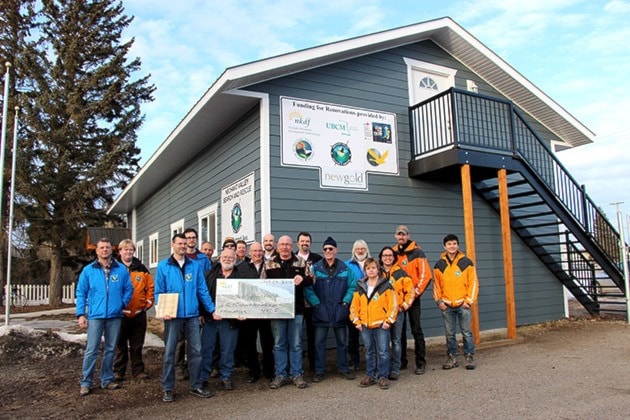With renovations finished and caution tape cut, Vanderhoof’s search and rescue team officially moved into its new home last week.
On Feb. 24, over 30 community leaders and supporters — including Maurie Hurst, northwest regional manager of Emergency Management BC, and Sgt. Svend Nielsen of Vanderhoof’s RCMP — attended the Nechako Valley Search and Rescue’s ribbon cutting ceremony for its new facility on Burrard Avenue.
Nechako-Kitamaat Development Fund Society, represented by its chairperson Wayne Salewski and director Ray Klingspohn at the event, presented a cheque of $61,768 to NVSAR for its renovation project.
“We are very pleased to be involved in projects such as this,” Salewski said. “This serves really well with what NKDF is about.”
Jeff Smedley and Trent Blair from Prince George Search and Rescue also presented a commemorative plaque to the team for its new home.
Formerly a governmental office for forestry, the new facility underwent modernization upgrades including full-building insulation, on-demand hot water, wheelchair accessible bathrooms with water-saving functions, replacement of a 35-per-cent efficient propane furnace with a 97-per-cent efficient natural gas device, as well as safety features such as all-weather exterior stairs and covered entrances, explained NVSAR president Chris Mushumanski.
At a total cost of $150,000, the renovation project was also supported by $20,000 from the District of Vanderhoof, contributions from the Regional District of Bulkley-Nechako gas tax fund, as well as $5,000 from New Gold’s Blackwater mining project.
“It’s an exciting day for Vanderhoof and area,” said Vanderhoof’s mayor Gerry Thiessen, who attended the ceremony with Councillor Ken Young. “It means so much for the community to have the resources to take care of search and rescue in the region.”
NVSAR had been without a home for several years, with offices and equipment scattered in various locations around town.
“Even though you get shuffled around to different places, you make it work,” said RDBN’s Jerry Petersen.
Next steps: new one-time funding from B.C.
Earlier this year, the provincial government announced $10 million of one-time funding to B.C.’s 80 SAR groups.
A committee of seven from the BC Search and Rescue Association is currently working on a plan to allocate the funds, slated to arrive by the end of March, to meet the various groups’ goals, explained Mushumanski, who is also the association’s Bulkley Nechako regional director.
“The intention lies in training, replacing equipment, offsetting administrative costs, search and rescue prevention,” he said, adding that the funding model will include how to determine the different amounts allocated to different groups according to their capabilities.
For example, the NVSAR currently has 26 active and 26 associate members, and is capable of search and rescue situations involving rope, on flat ice, in swift water, and on the ground.
The goal is to maximize the value of the one-time funding, potentially using the amount over two years or implementing a longer term prevention program and training, Mushumanski added.
Last fall, the association submitted to the provincial government three proposals of an alternative support model that would provide stable funding for B.C. SAR groups.
